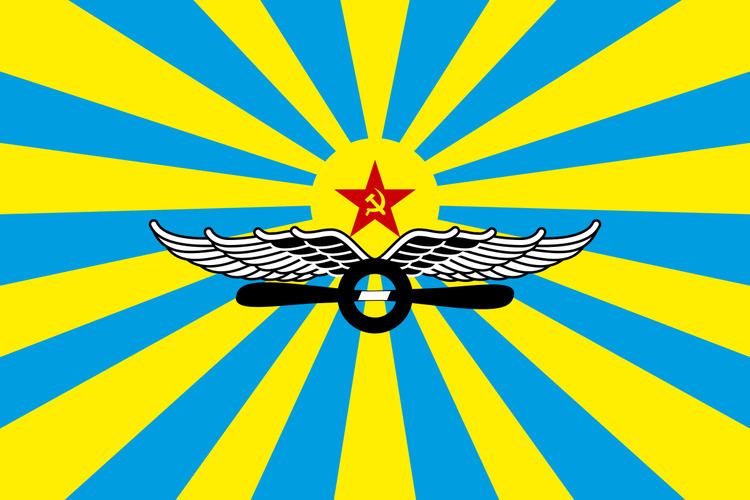 | ||
Active c.1945–presentSpecial Purpose Command: 2002 – July 1, 2009 Size World War II: several air divisionsToday: ~ 10–15 air regiments Notablecommanders Marshal Anatoly Konstantinov (dismissed 1988) | ||
The Special Purpose Command (Komandovaniye Spetsialnogo Naznacheniya) was a formation of the Russian Air Force, the strongest among the tactical aviation and anti-aircraft groupings. Its zone of responsibility amounted to 1.3 million km², taking in 40 million people, as well as the country's capital, Moscow. On July 1, 2009 it was superseded by the Aerospace Defense Operational Strategic Command (ru:Объединённое стратегическое командование воздушно-космической обороны).
Contents
- VVS and PVO Units in the District in the late 1980s
- 7th Air Defence Division 1995
- Moscow Air Defence District commanders
- 16th Air Army
- 2007 structure
- References
As a result of the air force reforms implemented on June 1, 1998, the Moscow District of the PVO and the 16th Air Army of VVS became a single entity, the Moscow District of the Air Force and Air Defense. According to Krasnaya Zvezda of 16 December 2002, the former Moscow District of the VVS and PVO was reorganised as the Special Purpose Command in September 2002. Interfax says the Moscow District was split into the reactivated 16th Air Army, a tactical force, and the Central Air Defence Zone, an air defense force.
Pyotr Butowski, writing in 2004, seems to indicate that the Special Purpose Command (he makes no mention of ‘the Central Air Defence Zone’) is merely essentially a redesignation of the former Moscow District. The rearrangement of the Moscow District of the VVS and PVO into the Special Purpose Command is apparently connected with plans in the long term for the military-space defense of the central industrial region.
The initial commanding officer of the KSpN was General Lieutenant Yuri Solovyov, later promoted to Colonel-General. The Moscow Air Defence District has a long history, dating back to the Second World War. Until 1950, MiG-15 interceptor regiments were concentrated in the Moscow District to protect the capital against US bomber attack. After 1950 significant elements, the 64th Fighter Aviation Corps, were redeployed to fight in the Korean War. The district's commander was replaced shortly before the Mathias Rust affair in 1988 for insufficient support of Mikhail Gorbachev's perestroika policy.
VVS and PVO Units in the District in the late 1980s
In the last days of the Soviet Union there was a considerable Soviet Air Defence Forces presence, and a smaller Air Forces presence, in the Moscow Military District. The Air Forces of the Moscow Military District, alternately known as the 78th Air Army, consisted of a reconnaissance regiment, the 47th Guards Separate Reconnaissance Aviation Regiment at Shatalovo flying Su-24MPs, and the 9th Fighter Aviation Division (9 iad), at Kubinka, with four regiments. The division incorporated the 32nd Guards Fighter Aviation Regiment, also at Shatalovo, with MiG-23MLDs, the 234th Guards Fighter Aviation Regiment at Kubinka with MiG-29s, the 274th Fighter-Bomber Aviation Regiment at Migalovo (274 apib) with Su-17s, and the 343rd Fighter Aviation Regiment at Sennoy with MiG-29s. Also part of the force was a ground signals regiment, the 131st. 32nd Guards Fighter Aviation Regiment served in Cuba as part of 'Operation Anadyr' during the Cuban Missile Crisis of 1963. The regiment was temporarily renamed 213th Fighter Aviation Regiment while in Cuba.
Joseph Stalin's son Vasily Stalin commanded the Moscow district air forces in the early 1950s. He was succeeded by General Colonel Stepan Krasovsky (1952–53), Lieutenant General Stepan Rybanov (June 1953 – 1959), and, later, Lieutenant General Igor Dmitriev (ru:Дмитриев, Игорь Михайлович) (1983-1989) and Nikolai Antoshkin (ru:Антошкин, Николай Тимофеевич) (1989–93).
Also part of the Moscow District air forces was the 4th Centre for Combat Employment and Retraining of Personnel at Lipetsk.
Moscow district air defence had been provided during the Second World War by initially the Moscow PVO Corps Region. The Corps Region Headquarters, then formed the Moscow Front PVO from 6 April 1942 – 10 July 1943. In turn, the Moscow Front PVO was redesignated as Headquarters, Special Moscow PVO Army. In 1948 the North-Western Air Defence District was redesignated the Moscow Air Defence Region, which became the Moscow Air Defence District in 1950.
In 1988 the Order of Lenin Moscow Air Defence District had four air defence corps and a division, which included 11 fighter aviation regiments, one transport helicopter regiment, 28 anti-aircraft rocket regiments, and four radar brigades and regiments. The corps were the 2nd, at Balashikha, 3rd at Rzhev, 7th at Kursk, and 16th at Gorky. One of the fighter regiments was the 472nd Fighter Aviation Regiment at Kursk. The 7th Air Defence Corps was redesignated the 7th Air Defence Division in the early 1990s.
7th Air Defence Division 1995
Source Holm.
The division was disbanded in 2001.
Moscow Air Defence District commanders
Source 1948–80: Holm
16th Air Army
The 16th Air Army (ru:16-я воздушная армия) was the most important formation of the Special Purpose Command. Initially formed during the Second World War as a part of the Soviet Air Force, it was from c.2002–2009 the tactical air force component of the Moscow Military District, headquartered at Kubinka.
2007 structure
In 2009 the Russian Air Force was extensively reorganised. This structure is not current. Combat Aircraft magazine's June 2010 issue gives some details of the new structure.
